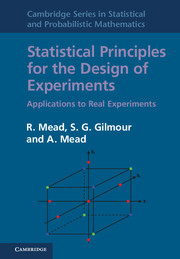Book contents
5 - Experimental units
from Part II - First subject
Published online by Cambridge University Press: 05 November 2012
Summary
Preliminary examples
(a) Gene expression studies using spotted microarray technologies allow the comparison of gene transcription responses for different experimental samples, such as plant samples taken from different plant lines (a wild-type and lines with different genetic mutations), having been exposed to different environmental conditions or inoculated with a pathogen, and possibly collected at different times after exposure or incoluation. Each microarray contains probes (spots) for a large number (many thousands) of genes, with these probes arranged in a rectangular grid within the microarray. Some microarray technologies only allow one sample to be hybridised to each array, but others (multichannel systems) allow a mixture of two (or more) samples to be hybridised to the array, with the samples being differentially labelled (using fluorescent dyes) prior to being mixed, and separate responses being measured for each of the fluorescent labels. Scientific interest is in both the patterns of gene expression measured for each probe across experimental samples, and in the relationships between gene expression responses measured for different probes within and between experimental samples. For multichannel systems, generally each combination of array and channel might be considered as the experimental unit, though considering the probe (gene) as a ‘treatment’ (as some analysis approaches do) suggests that each spot should be considered as the experimental unit. An added complication in most gene expression microarray studies is that the experimental samples will have been obtained from a field, glasshouse or controlled environment experiment, so that the design of this earlier experiment, and the various processing steps between initial experimental sample and microarray sample, should be considered in determining the structure of the microarray experiment. Similar issues arise with other ‘high throughput’ technologies used in molecular biology studies.
- Type
- Chapter
- Information
- Statistical Principles for the Design of ExperimentsApplications to Real Experiments, pp. 107 - 123Publisher: Cambridge University PressPrint publication year: 2012



